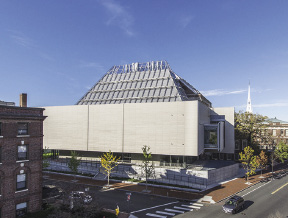Skanska USA has completed the renovation and expansion of the Harvard Art Museums complex located at 32 Quincy St., designed by architect Renzo Piano.
The new 204,000 s/f facility, targeting LEED Gold certification, brings together for the first time under one roof the Fogg, Busch-Reisinger, and Arthur M. Sackler museums.
"This project was an enormously challenging and rewarding undertaking," said Kerim Evin, executive vice president of Skanska USA. "As we performed each complex task to bring both Harvard's and Renzo Piano's vision to life, it was clear that each member of the team felt a special connection to the project. We value our long-standing partnership with Harvard, and are grateful for this once in a lifetime opportunity to revitalize the iconic and historic complex that will enrich the lives of residents and visitors for years to come."
"We knew that we had an opportunity to redefine the Harvard Art Museums as an accessible and connected 21st century facility for teaching and learning," said Thomas Lentz, Elizabeth and John Moors Cabot director of the Harvard Art Museums. "We also wanted to strengthen the museums' role as an integral part of Cambridge and Boston's cultural ecosystem. We look forward to welcoming students, faculty, and staff at Harvard, our Cambridge friends and neighbors, the entire Greater Boston community, and travelers from afar into our new home."
Work on the complete renovation of the existing structure and the new facility began in December of 2009. In addition to providing a 40% increase in gallery space, the project has also transformed the complex, adding study centers, a cafe, and a pyramid-like glass roof. It took more than 2,325 workers to complete the project.
Throughout the many challenges that Skanska overcame during construction, one was storing, moving and reinstalling famous works of art such as a fresco named "Structure," a 30,000 pound, 80-year-old fresco painted by Lewis Rubenstein, which depicts workers building the original 1927 Fogg Museum building. The multifaceted and complicated process of moving the painting is captured in this video.
Environmental sustainability was a priority on the project. Skanska created and executed a sophisticated Indoor Air Quality Management Plan to protect the existing spaces throughout construction. The team also achieved a 98% recycling rate by reusing or diverting large amounts of construction waste, such as concrete, wood, metal, glass. Additionally, Skanska customized the PDF program Bluebeam to electronically share sketches and drawings with the project team onsite. This system eliminated 95% of paper usage in the field, saving tens of thousands of dollars in printing costs. Finally, Skanska was able to save approximately $250,000 in energy costs by opting to use LED lighting throughout the construction site.
Tags:
Skanska USA completes Harvard Art Museums renovations and expansion; Renzo Piano provides design for 204,000 s/f facility
January 15, 2015 - Construction Design & Engineering
.png)







